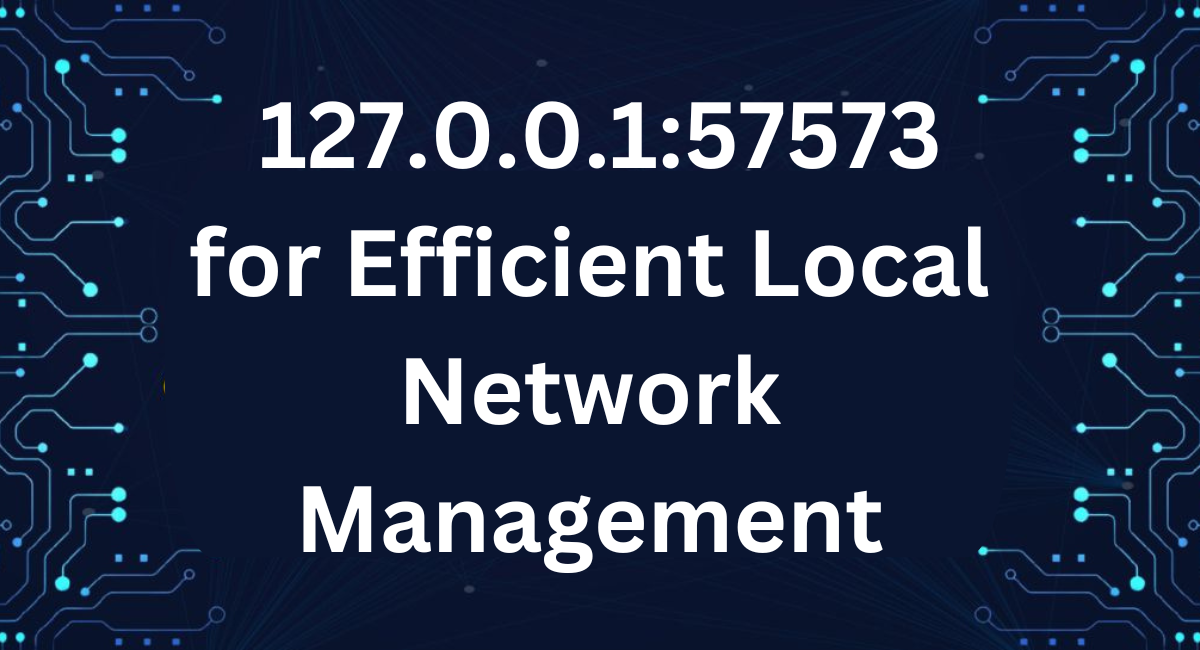In the world of software development and network management, the ability to efficiently manage local network traffic is essential. The IP address 127.0.0.1, known as localhost, allows applications to communicate with themselves on the same machine. When paired with a port like 57573, it provides a dedicated endpoint for local services. This article will explore how to use 127.0.0.1:57573 for efficient local network management, including setup, practical applications, troubleshooting, and advanced configurations.
Understanding Localhost and Port 57573
Localhost (127.0.0.1) is a loopback address that refers to the local computer, enabling applications to communicate internally without involving external networks. Port numbers, such as 57573, specify particular services or applications running on localhost, allowing multiple applications to operate concurrently without conflict.

Setting Up Local Network Management with 127.0.0.1:57573
- Configuring Your Service to Use Port 57573:
- To start using
127.0.0.1:57573, configure the service or application to listen on this specific port. This involves setting the port number in the service’s configuration file or as a command-line argument. For instance, if you’re running a local web server, you would specify the port in the server’s settings.
server --host 127.0.0.1 --port 57573 - To start using
- Testing Connectivity:
- After setting up your service, ensure it is accessible by opening a web browser or a network client and navigating to
http://127.0.0.1:57573. If configured correctly, you should see the service’s response or interface.
- After setting up your service, ensure it is accessible by opening a web browser or a network client and navigating to
- Monitoring Network Traffic:
- Use network monitoring tools like Wireshark or Netstat to observe and analyze traffic on port
57573. These tools can help you understand traffic patterns, identify performance bottlenecks, and detect unusual activity.
netstat -an | grep 57573 - Use network monitoring tools like Wireshark or Netstat to observe and analyze traffic on port
- Adjusting Firewall and Security Settings:
- Ensure that your local firewall or security software allows traffic through port
57573. Local firewalls might block non-standard ports, so adjust the settings to permit communication on this port.
- Ensure that your local firewall or security software allows traffic through port
Also Read : Localhost Communication Using 127.0.0.1:62893 | 10.10.10.2 in Network Security
Practical Applications
- Web Development:
- In web development,
127.0.0.1:57573can be used to host local development servers. This allows developers to test websites and applications in a controlled environment before deploying them to production servers.
- In web development,
- Database Management:
- Port
57573can be assigned to a local database management system for testing purposes. This setup allows developers to interact with the database and run queries without affecting live data.
- Port
- API Testing:
- For API development, using
127.0.0.1:57573enables testing of API endpoints locally. This setup allows for debugging and validation of APIs in a secure and isolated environment.
- For API development, using
- Network Security:
- Network security professionals use localhost ports for security assessments and penetration testing. Configuring a service on
127.0.0.1:57573helps simulate attacks and test security measures locally.
- Network security professionals use localhost ports for security assessments and penetration testing. Configuring a service on
Troubleshooting Common Issues
- Service Not Listening:
- If you encounter issues with connectivity, verify that the service is configured correctly and actively listening on port
57573. Use tools likenetstatto confirm that the port is open.
- If you encounter issues with connectivity, verify that the service is configured correctly and actively listening on port
- Connection Refused Errors:
- A “connection refused” error often indicates that no service is running on the specified port. Double-check the service configuration and ensure that it is properly started.
- Port Already in Use:
- If port
57573is in use by another application, you may face conflicts. Uselsofornetstatto identify the conflicting application and resolve the issue by changing the port number or stopping the conflicting service.
lsof -i :57573 - If port
- Firewall or Security Software Blocking:
- Check that local firewall rules or security software are not blocking traffic on port
57573. Adjust the firewall settings to allow connections to this port.
- Check that local firewall rules or security software are not blocking traffic on port
Advanced Configuration and Management
- Virtual Hosts and Domain Mapping:
- For more complex setups, configure virtual hosts to direct traffic from different subdomains to
127.0.0.1:57573. This allows you to test multiple services or applications on different local domains.
- For more complex setups, configure virtual hosts to direct traffic from different subdomains to
- Port Forwarding:
- Use port forwarding to redirect traffic from other ports to
57573. This can be useful for testing how your application handles traffic from different sources or simulating different network environments.
- Use port forwarding to redirect traffic from other ports to
- Load Balancing:
- Simulate load balancing by running multiple instances of your service on different ports and directing traffic to
57573. This setup helps test how your application performs under various load conditions.
- Simulate load balancing by running multiple instances of your service on different ports and directing traffic to
- Logging and Analysis:
- Implement detailed logging to capture traffic data and diagnose issues. Analyze logs to gain insights into service performance, detect errors, and optimize your local network management.
Security Considerations
- Secure Local Connections:
- Even though
127.0.0.1is not exposed to external networks, it’s crucial to secure local connections. Use encryption and authentication for sensitive applications to protect data.
- Even though
- Regular Updates:
- Keep all applications and services up to date to address security vulnerabilities. Regular updates help maintain a secure environment for local network management.
- Access Control:
- Implement access controls to restrict who can interact with services running on
127.0.0.1:57573. Ensure that only authorized users have access to sensitive services and data.
- Implement access controls to restrict who can interact with services running on
Also Read : 10.0.0.0.1 in Network Configurations | 192.168.0.200 for Router and Device
Conclusion
Using 127.0.0.1:57573 for local network management provides a powerful way to configure, test, and optimize services on your local machine. By following the guidelines outlined in this article, you can effectively set up and manage local services, troubleshoot common issues, and leverage advanced configurations for enhanced network performance. Whether you are developing applications, testing APIs, or conducting security assessments, understanding how to manage local network traffic with 127.0.0.1:57573 will help you achieve greater efficiency and reliability in your local network environment.
